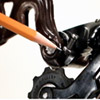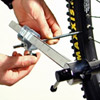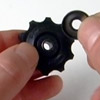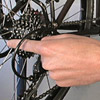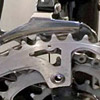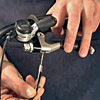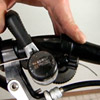How to Adjust Your Rear Derailleur
Applies to most 3-chainring derailleur systems. Adjust Front Derailleur
- How to Align a Rear Derailleur Hanger
- How To Install a Rear Derailleur
- How to Adjust Your Front Derailleur
Adjusting your rear derailleur can be frustrating. I’m hoping that this tutorial will help you understand how each component of your derailleur works, and how to set up and adjust it properly. Once your derailleur is set up correctly, most future adjustments can be done by hand. Let’s get started!
Required Tools
You’ll need a rag, a phillips screwdriver, a 5mm allen wrench, and a light lubricant like Triflow or Phil Wood Tenacious oil.
Rear Derailleur Components

How They Work
Almost all modern derailleurs function the same basic way. They are designed to move (or derail) the chain from one sprocket to the next. The upper guide pulley (or jockey pulley) moves the chain in both directions. For instance, when you want to climb a hill, you shift down to a lower gear. This pulls the shift cable and forces the guide pulley to change to a bigger sprocket. When you want to go faster, you adjust the shifter to a higher gear. This releases shift cable tension and allows the derailleur springs to pull the guide pulley back down to a smaller gear. Each time you shift gears, the length of chain changes. The lower tension pulley is spring-loaded to take up this slack.
Limit Screws
There are 3 adjustment screws – the B-Screw (B-tension adjustment), the H-Screw (high gear limit stop) and the L-Screw (low gear limit stop). Adjustments on these screws should always be made in 1/4 turn increments.
B-Tension Adjustment
The B-Screw controls the derailleur body’s angle in relation to the sprocket-set. Shift down to the largest sprocket and check the distance between the guide pulley and the large sprocket. If the guide pulley is rubbing on the sprocket, tighten the B-screw clockwise to increase tension and move the pulley away from the sprocket. If there is a large gap between the pulley and sprocket, loosen the B-screw until the pulley rubs the sprocket, and then tighten it until it just clears.
High Gear Limit Stop
The H-Limit screw high gear limit stop prevents the guide pulley from shifting any further past the highest gear and into the axle. In order to adjust it properly there must be no tension on the lower inner cable. If you feel tension, loosen the cable adjuster until there is none. Now check from behind how the chain is riding on the smallest sprocket. If it looks like it wants ride off into the axle, tighten the H-screw clockwise until it lines up. If it looks like it is rubbing on the next gear, loosen the screw until the chain is nicely centered on the sprocket. Now re-adjust the cable tension until the derailleur shifts smoothly down to the next gear.
Low Gear Limit Stop
The L-Limit screw prevents the guide pulley from shifting any further past the lowest gear and into the wheel spokes. Shift down to the lowest gear, step behind the bike, and check how the chain rides on the sprocket. If it looks like it wants to ride into the spokes, tighten the L-screw clockwise until it is centered on the sprocket. If it looks like it wants to shift down, loosen the screw until it lines up. As an extra precaution you can use your thumb to gently push the derailleur body and make sure the chain will not run into the spokes, as this could obviously have a nasty effect on both you and your bike.
Cable Adjustment
The cable tension adjuster defines how far up or down the derailleur moves. Step back so you can see the chain and sprocket alignment, and then through the gears in both directions, first shifting up two and down one, and then down two and up one. The chain should look centered on each sprocket. If it is rubbing on a larger gear it means there is too much tension on the cable. Loosen the tension by turning the adjuster clockwise. If it wants to jump down to a smaller gear it needs more tension. Increase the tension by turning the adjuster counter-clockwise.
You can also use sound to check the adjustment. There is always a base-level of noise that can be heard in every gear. This noise will increase in a slightly different way depending on which way the tension is out of adjustment. If there is too much tension you will hear a metallic rubbing sound, but if there is too little tension you will hear a clicking noise as the chain tries to jump to a smaller sprocket. There is usually a cable tension adjuster on your shift lever. With practice you will be able to make small cable tension adjustments while you are riding.
Lubrication
Now that the derailleur is adjusted, always apply a drop of lubrication to the derailleur’s many moving parts. This will help prevent wear from dirt and rust, and it will keep your gears shifting smoothly. Wipe away any excess lube and take your bike for a test ride to make sure all the gears are working smoothly.
That concludes our tutorial on rear derailleur adjustments… have fun!
Related Links
- Jim Langley: Rear Derailleur Adjustment
- Park Tool: Rear Derailler Adjustments
- Sheldon Brown: Derailer Adjustment
- Bicycle Torque Specifications
Recommended Tools
- Park Tool HXS-1.2 Hex Wrench Set
- Park Tool Wrench Combo Set
- Tri-Flow Superior Lube
- Park Tool SA-3 Heavy Duty Shop Apron
- Park Tool SK-3 Starter Mechanic Tool Kit
- Park Tool PK-3 Professional Tool Kit
Categories
Discuss this topic in the Bicycle Repairs and Mechanics Forum
What are the pros and cons of using a 26" tube on a 29" wheel?
Latest post 3 hours agoI recently upgraded after 20+ years from a 26" to a 29" wheel. Consequently, I have 8 new 26" tubes in my garage. I ride 90% mountain biking. Curious. Have you ever fitted a 26" tube on a 29"? What was the result? And would you recommend it?...
Read moreHow often check or change mechanical disc brakes
Latest post 4 hours agoI'm curious—how often or after how many miles do people typically check or change their mechanical disc brake pads? I've been bikepacking for a while but never really followed a maintenance schedule. A few weeks ago, I took my bike to a mechanic because I heard some noise. The mechanic did a quick overhaul, and I was sent on my way. However, a few weeks later, while descending steep hills, I s...
Read moreCassette shifting Problem
Latest post 5 days agoI just replace the 10 speed cassette on my Mountain bike. I decided to go for a largest cog with more teeth for an easier ride uphill.. I increased from 38T to 42T. I also replaced the chain and chainrings at the same time. When the bike was on the stand it ran through the gears well. I had the following problem when out riding. I had just ridden up a steep hill on the 22T chain ring and the ...
Read moreVariation in Conti GP5000 sizing?
Latest post 1 week agoI must have fitted 3 or 4 pairs of 25mm Continental GP5000 tires without any trouble whatsoever. On different brands of 622x15c rim, they went on without struggle or complaint. Older GP4000 also went on without trouble. However, the most recent set, bought a month ago, are probably the worst I've ever had in terms of the challenge I had to get them fitted. Has anyone else found such a big differ...
Read morePros & Cons of presta valve vs schrader valves
Latest post 3 weeks agoA question I've wanted to ask for a while now. From a personal point of view, what have you found to be the positives and negatives of these two valves? What would your preference be?...
Read moreGrip Shifters
Latest post 3 weeks agoCurrently renovating a child's bike. It has 24 inch wheels and is a suitable size for a 7-10 year old. Anyway it has grip shifters. it is a six speed with three chain rings on the front derailleur. On the rear derailleur the shifter does not appear to move the gear cable at all when shifting from 6 to 5 and 5 to 4. I am actually holding the cable with my finger and thumb against the cable cas...
Read moreLeft a bike outside on the balcony for couple of months. How to get rid of the rust?
Latest post 3 weeks agop6i6rfpm1ip41 (1).jpg (Size: 82.1 KB / Downloads: 541) Is there a way to get rid of that rust or do I need to replace certain components? More pics...
Read more9 speed chain on 8 speed bike
Latest post 3 weeks agoAll of my bikes are 7 or 8 speed and sometime in the past I bought a 9 speed chain for some unremembered reason. is there any reason not to use it on an 8 speed bike?...
Read moreRusty chain inspite of cleaning,lubing
Latest post 4 weeks agoHello, I was going to ask this question in @Flowrider’s post, but since this is a slightly different issue, I decided to start a new post. https://forums.bikeride.com/thread-9267.html I’m nowhere near the ocean, so salt-related rusting isn’t a concern. I’m currently in the ninth month of a long bikepacking trip, and sometimes I stay in one place for a week or longer. During this week or ...
Read moreColnago restoration
Latest post 2 months agoHi everyone. A bit repetitive from my intro in GF, but this is the correct section for this post. I’m new to vintage bikes, but I’ve been eyeing a vintage Colnago to restore for a long time. Finally found one and the timing was right to pull the trigger. I’m still trying to identify the exact year, but from my research it’s 1991-1993 Colnago Super PiU. Mostly original, I think, apart from ...
Read moreColumbia 3 wheel differential
Latest post 2 months agoHello everyone and thank you so much for having me! I have an older Columbia 3 wheeler adult tricycle and she has a differential, somewhat like a car. I wanted to open up the differential for cleaning and oiling but cannot find any info on her, as to how much oil to add, and where the oil fill point is. Can anyone help me in this endeavor? I'd really love to get her going but don't want to ris...
Read moreFront derailer not moving
Latest post 2 months agoHi, I been upgrading my old bike with new brake and shift cables. I got my brakes working and now trying to get my shift cables working. I was able to install new shift cable, I made sure to hold the cable tight and tighten the Bolt to keep in place. But it doesn't move the derailer at all when shifting. I have a feeling it's a simple fix that I'm missing something. I thought it might be the new ...
Read moreWhat are the best cost effective ways to prevent chain rust?
Latest post 2 months agoI live 5 km from the ocean (not sure if that's relevant), and I pretty much only mountain bike. After every ride, I hose down and clean my bike. I wipe them down with a cloth. After a few days, the ones not ridden have what looks like surface rust appear on the chain. Do you have any cost-effective remedies to solve this issue?...
Read moreHow to deal with rusty chain
Latest post 2 months agoThe best thing is not to let your chain get rusty in the first place. Chains for most 6,7,8 speed bikes can be had for $15 to $20 all day long. For me my first choice is to just replace it and the reason is simple. If finished it does not meet the level of 95%+ perfect it will get replaced. If the chain you are trying to save does not have a quik link then that is an extra cost to figure...
Read moreRear v-brake repair
Latest post 3 months agoHi everyone, I'm new here and I've been trying to avoid taking my bike to a mechanic and save some money. I succesfully fixed my front but struggle with the rear, I got new brakes for the rear. I notice i think it might be the housing causing the noodle to be off centered and making the left brake pad to close to the rim. Any help would be greatly appreciated, thanks!! My next project is to attemp...
Read more